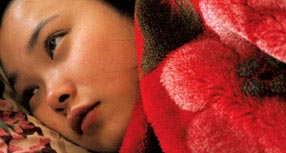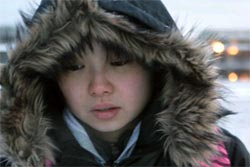“Yellow is a difficult color to wear.”
It was the first Saturday of the 25th San Francisco International Asian American Film Festival, and I heard these words from the couple standing behind me in line. They were noting the shirts that the festival volunteers were wearing, speaking in aesthetic terms, but as soon as I heard those words, I thought: And there’s a perfect way to start this essay …
Twenty-five years after it was first launched, the SFIAFF indeed shows how difficult the color yellow is — but in a positive sense. Like a den mother taking in wayward orphans, the festival takes in every kind of film (narrative, documentary, long, short, irreverent, deadly serious) from every country out there, suggesting that being “yellow” means, well, being a citizen of the world, which means that it can mean just about anything. And just when you’re ready to categorize the whole thing as some kind of triumph for boundary-free indie spirit, it then throws in a few marquee projects with big-name stars to give everyone the idea that Asian American cinema may be the Next Big Thing (this year’s biggie was Dark Matter with Meryl Streep, which I didn’t have the chance to see, but if the Variety review is any indication, it suggests that Asian American narrative cinema is as problematic as ever).
So in short, the festival is and has always been a mound of conflicting impulses, as every good film festival should be, and as I settled in for this year’s batch of films (mostly narrative — I still remain a sucker for good fiction), I was eager to see if yellow cinema was pursuing interesting new directions. For the most part, I wasn’t disappointed.
In Between Days (2006, Dir. So Yong Kim)
 |
yesterday i got so scared
i shivered like a child
yesterday away from you
it froze me deep inside
come back come back
don’t walk away
come back come back
come back today
come back come back
why can’t you see?
come back come back
come back to me
— “In Between Days,” The Cure
One of the pleasures of festivals like this is seeing work that won’t soon (if ever) hit the distribution circuit. Case in point is this film by So Yong Kim, who up to now has focused on art installations and short experimental films (see Indiewire for a good interview with the director). Even though the movie won a jury prize at Sundance and has made the festival rounds, it probably won’t be coming to an art house cinema near you anytime soon.
Shot over 24 days on digital video and loosely based on Kim’s experiences as a displaced immigrant in LA, In Between Days is a forlorn little movie. The story is minimalist (some would say plot-less): 15-year old Aimie (first-time actor Jiseon Kim) has relocated with her mother to a cinderblock apartment complex in Toronto. During the day, she plays hooky with Tran (Taegu Andy Kang), a fellow Korean immigrant and would-be tough guy who has a knit cap forever planted on his head, Eric Cartman-style. At night, the two of them hit local parties, break into cars, and make halting, darting conversation with each other — the painfully real, fumbling conversation of teens who know that they want something, but don’t know exactly what they want. As their relationship takes two steps back with every one step forward, the little things — an expensive bracelet as a gift, a stolen graduation photo, a homemade tattoo that scars horribly — gain totemic significance. Interspersed with this larger story are random shots of a blurry, bleak Toronto winterscape, with Aimie reciting what appears to be a letter. We eventually learn that these are messages to her father, who ran out on the family long ago. When she says “I think you’ll really like it here” in the most disconsolate voice imaginable, the misery is palpable.
 |
So the film isn’t a barrel of laughs, and it doesn’t build to the usual explosive climax (emotional or otherwise), but it bears watching. The movie belongs to Jiseon Kim (amazingly, this is her first big-screen performance), and she’s completely natural and believable as Aimie. Not your typical airbrushed teen beauty, she’s a bit heavy, with a shy, sullen face, and the unforgiving camera often catches her in looming close-ups, searching for signs of disclosure and weakness. It’s to her credit that she can bring out the drama and delicacy of her character’s adolescence under such close scrutiny. I found the cinematography striking — it captures the full-on January bleakness of Toronto, and it makes the most of natural lighting and everyday settings (a snow-covered field, a bus stop hidden behind a pane of glass, a cramped, dim apartment).
Overall, the film is very much in tune with the painful realities of growing up, minus the soap opera dramatics, which is its strength and its weakness. Grabbing hold of a particular place and time rather than relying on plot movement, what little there is of the story peters out after the first hour, and everything ends on an ambiguous note that suggests that relationships may be fleeting — or just constantly in flux. So brittle it feels like it might melt like a snowflake in your hand, you could call In Between Days nothing more than a pure mood piece, but as such it has loads of texture, and deserves to be watched on a dark, dreary night, when even the thought of loneliness seems somehow attractive. Even though the Cure tune quoted above isn’t referenced directly in the movie, both share the same plaintive, simple edge, and the sense of a life in limbo.
